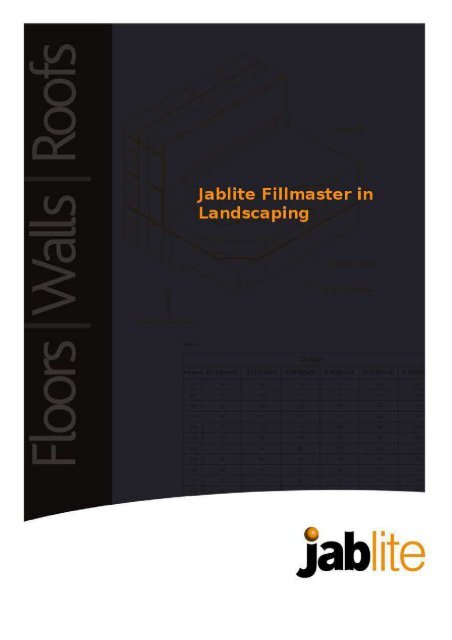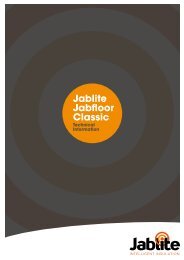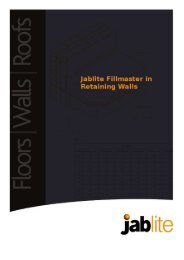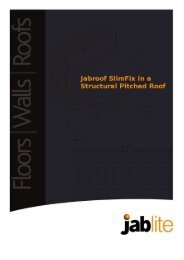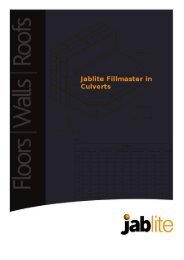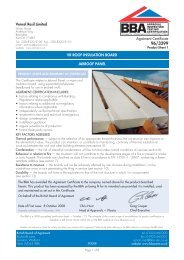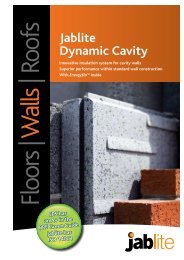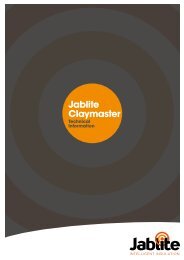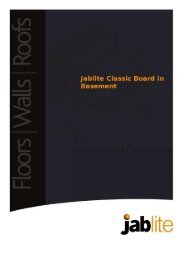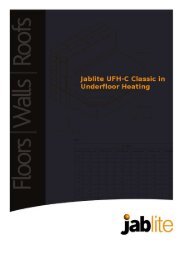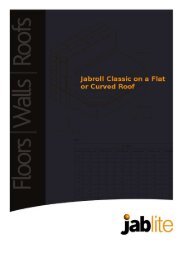Jablite Fillmaster in Landscaping
Jablite Fillmaster in Landscaping
Jablite Fillmaster in Landscaping
- No tags were found...
Create successful ePaper yourself
Turn your PDF publications into a flip-book with our unique Google optimized e-Paper software.
8Design ConsiderationTraditional fill materials used to construct new embankments orplaced aga<strong>in</strong>st civil eng<strong>in</strong>eer<strong>in</strong>g structures, can cause unacceptablevertical and/or horizontal stresses <strong>in</strong> the underly<strong>in</strong>g soil or aga<strong>in</strong>stthe structure. The use of <strong>Fillmaster</strong> expanded polystyrene as a fillmaterial offers a reliable, cost-effective lightweight solution tothese problems, reduc<strong>in</strong>g the probability of further settlement orunacceptable lateral forces and often simplify<strong>in</strong>g the construction.Vencel Resil manufactures <strong>Fillmaster</strong> expanded polystyrene (EPS) blocksfor use <strong>in</strong> civil eng<strong>in</strong>eer<strong>in</strong>g projects, especially road construction. Thematerial is available <strong>in</strong> a range of sizes and strength grades. The cellularstructure of the EPS material gives a high strength-to-weight ratioensur<strong>in</strong>g that the blocks are able to withstand the mechanical loadsencountered <strong>in</strong> road construction.Advantages■ Lightweight and easy to handle on site. Approximately 1% of theweight of traditional fill materials.■ Available <strong>in</strong> a range of grades allow<strong>in</strong>g the appropriate compressivestrength to be chosen to suit each particular application.■ Closed-cell structure <strong>in</strong>hibits water absorption.■ Unaffected by normal range of climatic conditions.■ Immune to <strong>in</strong>sect, bacterial and fungal attack.Descri ptionGrade<strong>Fillmaster</strong> is supplied <strong>in</strong> the grades shown <strong>in</strong> Table 1. Normally suppliedas Euroclass F def<strong>in</strong>ed to BSEN 14933: 2007, it is also available asEuroclass E, flame-retardant additive material, if required.Dimensions<strong>Fillmaster</strong> standard block size:2440 x 1220 x 610mm; other sizes available to order to reduce theneed for cutt<strong>in</strong>g to size on site. The stability of a lightweightembankment depends greatly on the uniformity of the blocks.Tolerances: ±3mm on thickness; ±4mm on width; and ±6mm onlength. Maximum bow, 5mm over length of block.ApplicationExpanded polystyrene has been successfully used as a fill material forhighway embankments s<strong>in</strong>ce 1972. Its first such use <strong>in</strong> the UK was <strong>in</strong>1985. The material is particularly beneficial <strong>in</strong> the follow<strong>in</strong>g situationswhere its use will obviate the need for either specialised foundations,or long surcharge periods designed to preload the ground and reducesettlement problems follow<strong>in</strong>g construction:■ Areas adjacent to exist<strong>in</strong>g embankments.■ Areas of unstable ground.■ Areas of weak or compressible soil.■ Sites where access is difficult or restricted.■ Ransition zones between bridges or underpasses and normal fillmaterials.Figure 1. HA Load<strong>in</strong>gs<strong>Fillmaster</strong>blocksPavementconstructionBuoyancyReduceddeadload ofstructureCompactedsand-levell<strong>in</strong>gcourse
9Table 1Physical Properties – <strong>Fillmaster</strong>Design<strong>Fillmaster</strong> Grade FM50 FM70 FM100 FM150 FM200 FM250 FM300 FM350 FM400 FM500CompressiveStress at 1%stra<strong>in</strong> (kPa)Embankment forcesThere are three ma<strong>in</strong> design considerations when construct<strong>in</strong>gembankments us<strong>in</strong>g <strong>Fillmaster</strong>:10 20 45 70 90 100 120 140 160 190■ Downward pressure due to wheel load<strong>in</strong>gs and the self-weight of theembankment.■ Upward forces due to buoyancy <strong>in</strong> wet conditions.■ Lateral forces act<strong>in</strong>g aga<strong>in</strong>st abutments.Wheel load<strong>in</strong>gsIn order to avoid unacceptable deflections and permanent deformationof the highway surface, the compressive stresses due to wheel load<strong>in</strong>gs,etc., should be carefully calculated and the appropriate grade of<strong>Fillmaster</strong> selected to ensure that these fall with<strong>in</strong> the designcompressive strength of the material. It is recommended that this iscarried out <strong>in</strong> accordance with the method of calculation for thethickness of sub-base/subgrade set out <strong>in</strong> BS 5400. This uses theconvention of ‘HA’ and ‘HB’ units of load<strong>in</strong>g.HA load<strong>in</strong>g assumes a s<strong>in</strong>gle 100kN wheel load exert<strong>in</strong>g a pressure of1110kPa over a square of 300 x 300mm; the pressure is exerteddownwards at a gradient of 2:1. This represents the effects of normallypermitted vehicles.Design ConsiderationHB load<strong>in</strong>g represents the effects of abnormal loads on motorways andtrunk roads. It is usual to design for 45 units of HB load<strong>in</strong>g; thisrepresents the effect of 16 wheel loads each of 112.5kN exert<strong>in</strong>g apressure of 1110kPa over a square of 318 x 318mm. The pressure isdispersed downwards at a gradient of 2:1.See Figures 2 and 3.Figure 2. HA Load<strong>in</strong>gsDepth <strong>in</strong> metresbelow surface10070452721S<strong>in</strong>gle nom<strong>in</strong>alwheel HA load<strong>in</strong>g1 x 100kNFigure 3. HB Load<strong>in</strong>gsDepth <strong>in</strong> metresbelow surface4 x 112.5 4 x 112.5 4 x 112.5 4 x 112.5Approx pressure kN/m 245 Units ofHB Load<strong>in</strong>gFor technical <strong>in</strong>formation 0870 444 8769 technical@vencel.co.uk
10Design ConsiderationDownward pressureWhen calculat<strong>in</strong>g the self-weight of <strong>Fillmaster</strong> blocks an allowanceshould be made for water absorption of less than 1% by volume.This gives a design weight of approximately 100kg/m 3 .Buoyancy pressuresEPS is a proven flotation material and exerts a flotation force of900kgf/m 3 .This takes <strong>in</strong>to account a potential level of water absorption of 8% forblocks which are permanently submerged.Care must be taken dur<strong>in</strong>g the design process to ensure that thepotential flotation forces can be accommodated with<strong>in</strong> thehydrological conditions of the site and take account of the self weightof the permanent structure.Alternatively, the material can be <strong>in</strong>stalled above the water table.The water table can be lowered by <strong>in</strong>stall<strong>in</strong>g suitable cut-off dra<strong>in</strong>s atthe toe of the embankment or beneath the embankment itself.Lateral pressuresWhen us<strong>in</strong>g <strong>Fillmaster</strong> for approach embankments to bridgeabutments, the horizontal forces exerted on the abutment are almosteradicated. This allows economies to be made <strong>in</strong> the design of bridgefoundations, which are no longer required to resist large rotationalmoments.InstallationConstruction of the embankment should proceed as follows:Levell<strong>in</strong>g course<strong>Fillmaster</strong> blocks are placed on a levell<strong>in</strong>g course consist<strong>in</strong>g of a layer ofcompacted sand to a maximum thickness of 100mm. This courseshould be laid to a level tolerance not exceed<strong>in</strong>g ±10mm over any 3mlength. On sites which have very soft foundations, a geotextile layermay be placed on top of the soft soil before plac<strong>in</strong>g the sand fill, thisprevents the sand from be<strong>in</strong>g ‘punched’ <strong>in</strong>to the soil.Lay<strong>in</strong>g the blocksThe blocks <strong>in</strong> each layer should be laid with broken jo<strong>in</strong>ts; there shouldbe no vertical or horizontal jo<strong>in</strong>ts runn<strong>in</strong>g through the construction.There is no need to compact the blocks dur<strong>in</strong>g construction.The coefficient of friction (µ) between adjacent blocks can be taken as0.5; this is normally sufficient to prevent any slippage or movement.When required, for example at the edges of the embankment,a positive fix<strong>in</strong>g can be obta<strong>in</strong>ed by driv<strong>in</strong>g 12mm diameter re<strong>in</strong>forc<strong>in</strong>gbars down through the layers.The f<strong>in</strong>al profile of the side slope will depend on the properties of thesoil used. Where soil conditions restrict the available space for anembankment, a range of techniques is now available for construct<strong>in</strong>gsteep sides or vertical faces.Cutt<strong>in</strong>gBlocks which require trimm<strong>in</strong>g can be easily cut us<strong>in</strong>g a hot-wire cutter,handsaw or cha<strong>in</strong> saw.ProtectionThe <strong>Fillmaster</strong> should be protected from possible accidental contactwith petroleum or solvents us<strong>in</strong>g a suitable polymer barrier, wherenecessary.Fill or capp<strong>in</strong>g layerThe f<strong>in</strong>al fill should be placed over the <strong>Fillmaster</strong> blocks tak<strong>in</strong>g care notto puncture any membrane.No construction plant, other than compaction equipment, should bedriven across, or placed on the <strong>Fillmaster</strong> until there is a m<strong>in</strong>imumcover of 200mm of acceptable fill material, or until the capp<strong>in</strong>g layerhas been placed.Vibratory compaction plant should not be used with<strong>in</strong> 500mmvertically, or 2m laterally, of the <strong>Fillmaster</strong> blocks.CoverThe sides of the <strong>Fillmaster</strong> blocks should be covered with general filland compacted <strong>in</strong> layers. The sides should be graded and covered withtop soil. The m<strong>in</strong>imum cover should be 300mm.ReferencesBS 5400 Steel, concrete and composite bridges. Part 2 Specification for loads. Department of Transport Standard BD 37/88. Loads for highway bridges.Geotechnical considerations and techniques for widen<strong>in</strong>g highway earthworks. Department of Transport.Plastic foam <strong>in</strong> road embankments. Proceed<strong>in</strong>gs of the conference of the Norwegian Plastics Federation. June 1985.TRL Contractor report 356. The use of polystyrene for embankment construction.
11Design ConsiderationFor technical <strong>in</strong>formation 0870 444 8769 technical@vencel.co.uk
26Landscap<strong>in</strong>gThe light weight and high strength-to-weight ratio of <strong>Fillmaster</strong>make it an ideal fill material for both hard and soft landscap<strong>in</strong>gapplications where it reduces the pressure on underly<strong>in</strong>g structuresand services.Figure 17. Landscap<strong>in</strong>gSoil cover<strong>Fillmaster</strong> BlocksUnderground servicesSignificantly lower loads than wouldbe experienced with traditional fillsenabl<strong>in</strong>g construction on weakersub-soil structuresSand-levell<strong>in</strong>g course
27Figure 18. Landscap<strong>in</strong>g<strong>Fillmaster</strong> blocksSignificantly lower loads than would be experienced withtraditional fills enabl<strong>in</strong>g construction on weaker sub-soilstructuresSoil coverLandscap<strong>in</strong>gSand-levell<strong>in</strong>g courseUnderground servicesRheged Upland K<strong>in</strong>gdom Discovery Centre, Slapestones, PenrithGLA Build<strong>in</strong>g – Lord Mayor’s Office. LondonRheged Upland K<strong>in</strong>gdom Discovery Centre,Slapestones, PenrithCumbria’s new Discovery centre near Penrith, built <strong>in</strong> an old redundantquarry, was designed to blend back <strong>in</strong>to the hilly local landscape.Toachieve this, <strong>Fillmaster</strong> blocks were laid on the roof of the centre tocreate a natural hill profile. Reach<strong>in</strong>g 19m from the floor to its peak,<strong>Fillmaster</strong> satisfied the severe roof load<strong>in</strong>g restrictions as it weighs only1% of traditional fill materials.Vencel Resil provided layer-by-layer detailed draw<strong>in</strong>gs enabl<strong>in</strong>gcontours to be formed and the overburden kept to a m<strong>in</strong>imum.Client: Westmorland PropertiesDesign: Unw<strong>in</strong> Jones Architects with A.L. Da<strong>in</strong>es Eng<strong>in</strong>eersContractor: Cumbrian Industrials subcontract<strong>in</strong>g to M&J Roof<strong>in</strong>gVolume: 3500m 3GLA Build<strong>in</strong>g – Lord Mayor’s Office, LondonThe immense build<strong>in</strong>g project surround<strong>in</strong>g the new Lord Mayor’s officesituated adjacent to Tower Bridge <strong>in</strong> London called for a hard landfillmaterial that could deliver quick and easy <strong>in</strong>stallation, as well aseffectively create <strong>in</strong>creased structural load-bear<strong>in</strong>gs. In view of awatertight underground service tunnel that runs beneath the entirearea, <strong>Fillmaster</strong> 150 and <strong>Fillmaster</strong> 500 were chosen as the mosteconomic and suitable grades of material to fulfil the specifiedrequirements. The <strong>Fillmaster</strong> product was the ideal solution becauseeach block can be cut to virtually any profile and fitted together like ajigsaw puzzle. Extremely versatile, <strong>Fillmaster</strong>’s exceptional strength-toweightratio reduces pressure on underly<strong>in</strong>g structures whilst provid<strong>in</strong>ga firm foundation for the subsequent concrete and dist<strong>in</strong>ctive IrishLimestone pav<strong>in</strong>g f<strong>in</strong>ishes.contours to be formed and the overburdenkept to a m<strong>in</strong>imum.Client: GLAConsult<strong>in</strong>g Eng<strong>in</strong>eers: ArupContractor: McNicholasVolume: 1500m 3For technical <strong>in</strong>formation 0870 444 8769 technical@vencel.co.uk
For more <strong>in</strong>formation about<strong>Jablite</strong> please contact us on:Tel: 0870 600 3666Email: sales@jablite.co.ukVisit: www.jablite.co.uk<strong>Jablite</strong> LimitedHead Office: Inf<strong>in</strong>ity House, Anderson Way, Belvedere, Kent DA17 6BG


